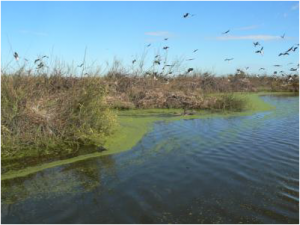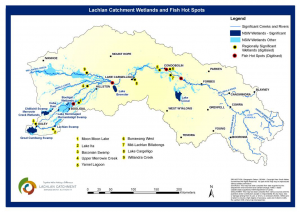
WETLAND WATERING
Merrowie Creek/Lake Tarwong:
A managed stock and domestic replenishment flow was delivered to the Merrowie Creek in spring 2010.
Environmental water was ordered to supplement the replenishment flow to enable inundation all the way to Cuba Dam. This order was cancelled after only some 830ML had been delivered owing to significant local rainfalls which lead to minor to moderate inundation in the mid-Merrowie Creek area. The combined volumes of water in the Merrowie were sufficient to carry flows on beyond Cuba Dam towards Tarwong Lake.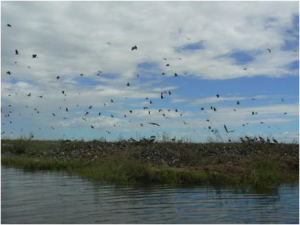
On 3/11/10 it was confirmed that inundation at Cuba Dam had triggered colonial nesting of straw necked ibis (approx 500 pairs) 2.5km upstream of the Dam. Subsequent observations on the ground indicated that the colony was actively expanding. Analysis of high resolution digital vertical photography captured over 10,000 nests in the area on 12/12/10.
The aim of the second phase of watering was to deliver 3,000ML to Merrowie Creek at 120ML/day to support the completion of the bird breeding event and to inundate Lake Tarwong. E-water flows into Merrowie Creek commenced on 16/11/10 and concluded on 13/12/10. The head of the environmental flow arrived at Tarwong on 26/12/10. Total volume of environmental water delivered was 3000ML. See Tables 1 and 2 for more detail.
Tarwong Lake is currently full as a result of the environmental flows, combined with above average rainfalls in the area.
Booligal Wetlands
The Booligal waterbird breeding event was triggered by a managed stock and domestic replenishment flow in the Merrimajeel Creek. On 21/10/10 preliminary stages of a breeding event were observed on Lachlan Valley State Conservation Area (Booligal Station) involving >15,000 straw-necked ibis. Small numbers of glossy ibis were also observed congregating on the Merrimajeel Creek upstream of the main colony.
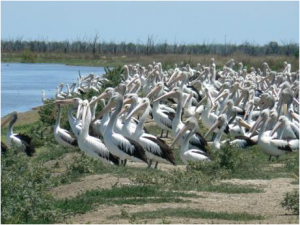 Following the conclusion of the replenishment flow, intervention was required to prevent the water levels at the colony site receding rapidly leading to abandonment of nests and failure of the breeding event. E-water was ordered to support the event. To maintain water levels at the site prior to arrival of the E-water from Lake Brewster, and subsequently during the breeding event, it was necessary to install and adjust boards in the Block bank regulator.
Following the conclusion of the replenishment flow, intervention was required to prevent the water levels at the colony site receding rapidly leading to abandonment of nests and failure of the breeding event. E-water was ordered to support the event. To maintain water levels at the site prior to arrival of the E-water from Lake Brewster, and subsequently during the breeding event, it was necessary to install and adjust boards in the Block bank regulator.
The numbers of straw-neck ibis increased to at least 64,000 pairs, with glossy ibis, royal spoonbills,white ibis, freckled ducks, blue-billed ducks and grebes also breeding.
It has only been necessary to deliver environmental water for 59 days at an average rate of 40ML/day (approx. 2,360ML) to support the event. See Tables 1 and 2 for more detail. Only 59 days of E-water delivery was required as natural high flows in the river entered the creek in late December 2010 and these were sufficient to support the event until its conclusion in February 2011.
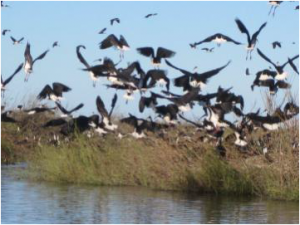 In the Booligal wetlands in NSW, about 120,000 young straw-necked ibis have just left their nests after one of the most successful breedings in the area’s recent history.
In the Booligal wetlands in NSW, about 120,000 young straw-necked ibis have just left their nests after one of the most successful breedings in the area’s recent history.
Paul Packard, wetlands and river conservations officer with the Department of Environment, Climate Change and Water, says “It couldn’t have happened without the locals. They are the eyes and ears on the ground, they alerted us, they noticed the birds were beginning to congregate, called us up and said ‘look the water is dropping’, so then everyone can do their bit.
-
ABC Rural News, 14/02/2011
LACHLAN RIVERINE WORKING GROUP (LRWG)
The LRWG deals with:
- allocation, accounting and management of E-water ;
- water delivery strategies;
- reviewing river operations and policies in relation to E-water;
- the sustainable management of water-dependent ecosystems; and,
- communicating with the public and stakeholder groups.
WATERING SUMMARY
Watering Outcomes:
- Lake Brewster Pelican breeding & macrophyte establishment
- Booligal waterbird breeding
- Merrowie Creek waterbird breeding and Lake Tarwong inundation
Other Waterbird Breeding Events
Lake Brewster: The Lake Brewster inflow wetland provides semi-permanent wetland habitat. While the Lake Brewster outflow wetland has the long-term objectives of improving water quality and providing ephemeral wetland functions.Operational flows to Lake Brewster commenced at the end of September 2010 and as at March 2011 there was approximately 98,552ML in the main storage cell, 7,550ML in the outflow wetland and 3,543ML in the inflow wetland, making a total of 109,645ML held in storage.
These inflows sparked a Pelican breeding event on the banks of the outflow channel and the outflow wetlands. More than 4000 eggs have been observed, which is the largest Pelican breeding event in NSW for over 5 years. Aquatic plants have also begun to establish in the inflow wetland. The breeding event is likely to last until April/May 2011. Tables 1 and 2 summarise the sources, volumes and outcomes delivered water in relation to Lake Brewster.
Table 1 Water Accounting
| Asset | Volume | Commencement date | Completion date | Duration of flows | Ewater Outcomes |
| Brewster Inflow Wetland | Foregone storage to facilitate aquatic plant growth may be accounted for using a proportion of E-water | NA | NA | NA | Successful aquatic plant establishment |
| Brewster Outflow Wetland | Foregone storage to facilitate aquatic plant growth & protection of pelican breeding may be accounted for using a proportion of E-water | NA | NA | NA | Largest pelican breeding in NSW in 5 years (>4000 eggs) |
| Merrowie Creek and Lake Tarwong (Tarwong not included as target for replenishment flow) | 12300ML (replenishment) | 25/8/2010 | 18/10/2010 | 56days | Contributed to triggering of a bird breeding event |
| 830ML (E-water)3000ML (E-water) | 13/10/201016/11/2010 | 19/10/201013/12/2010 | 7days28days | Contributed to triggering of a bird breeding event Successful water bird breeding; contributed to filling Lake Tarwong | |
| Booligal Wetlands | 9000ML (replenishment) | 30/8/2010 | 29/10/2010 | 60 days | Colonial water bird breeding event triggered |
| 2360 (E-water) | 29/10/10 | 26/12/10 | 59 days | Breeding event supported to conclusion. Over 120,000 ibis fledged. Flows continued on to Murrumbidgil Swamp |
Table 2 Environmental Water Delivery October 2010 to March 2011
| Water Management Area | Water Source | Average Discharge (ML/D) | Duration (days) | Volume (ML) | |||
| Merrowie Creek (incl. Tarwong) | Replenishment/ Operational | 150ML/day @ Gonowlia Weir | 56 | 12300 | |||
| Riverbank (830ML) | 120ML/day @Gonowlia Weir | 7 | 830 (TBC) | ||||
| Riverbank (855ML);Commonwealth Environmental Water Holder (2145ML) | 120ML/day@Gonowlia Weir | 28 | 3000 (TBC) | ||||
| Merrimajeel Creek (Booligal Wetlands) | Replenishment/ Operational | 150ML/day @Torriganny Weir | 60 | 9000 | |||
| Riverbank (787ML);Commonwealth Environmental Water Holder (1573ML) | 40ML @ Torriganny Weir | 59 | 2360 | ||||
| Total Volume (ML) | 21300 replenishment6190 E-water | ||||||
PROJECT UPDATE
Working Wetlands: The aim of this project is to protect and enhance significant wetlands in the lower Lachlan. The project involves working with local landholders to implement management options to facilitate environmental services provided by the wetlands. Activities to date include feral animal and weed control on lower Lachlan wetlands. The project is complemented by the LEWMP that guides the allocation of environmental water to priority sites thus leading to an improved wetting and drying cycle.
River Revival – Carp Cleanup: Carp have long been acknowledged as a priority pest animal and identified as a key threat to the Lower Lachlan. Implementation of Carp control activities in 2010/11 have included a feasibility study and business plan for ongoing commercial carp fishing in the Lachlan and the management of Carp Separation Cages (CSC) that have been constructed, community engagement through recreational fishing events and Clean-up a Lachlan Carp Day and large scale carp biomass reduction through commercial fishing operations.
Habitat Restoration: As part of the River Revival project the LCMA are targeting the restoration of high quality habitat to promote native fish recruitment. This will help native fish to build resilience resilience from impacts of carp populations. These activities will be guided by foundational science to determine the high value priority reaches within the Catchment. Targeted reaches will be become priorities for community engagement and on ground works. Best practice riparian rehabilitation will be undertaken in these priority reaches with willing land managers. Community based demonstration reaches will also be supported throughout the catchment to increase knowledge and awareness within the catchment community.
Native Fish Refuge: This project is investigating how low flows impact on pool habitats in the Lachlan River. No or low flow periods are known to impact on isolated pools and their value as refuges for aquatic communities as the key processes that shape fish communities such as water quality, habitat, prey availability and predation alter under these conditions. Currently, there is a lack of knowledge on key issues such as (i) what are the water quality conditions within refuge pools during low- and no- flow periods, (ii) what happens when flows are re-instated at various times of the year (iii) at what rates are habitats within deep pools and shallow reaches used during low flow periods, and (iv) how are reaches re-colonised after they have dried out.
On-Farm Irrigation Efficiency: The Australian Government allocated $300 million to the Water for the Future initiative, in which LCMA and Lachlan Valley Water (LVW) are partners in delivering the On-Farm Irrigation Efficiency Program throughout the Lachlan Catchment. At least 50% of water savings generated from improved on-farm water use and management are returned to the Australian Government and managed by the Commonwealth Environmental Water Holder (CEWH). The LCMA and LVW attracted in principle approval for funding of up to $3.85million in round 1.
